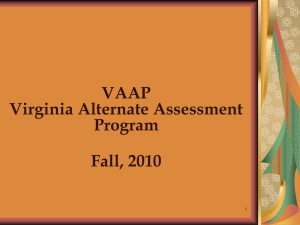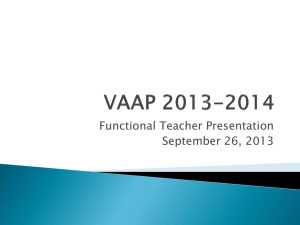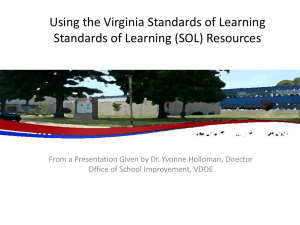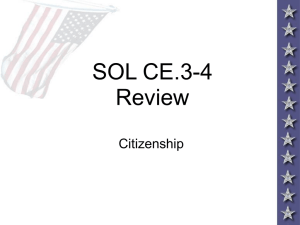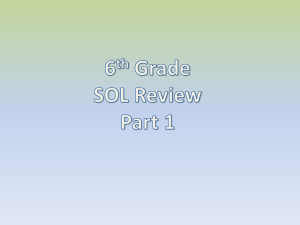VGLA 2013-2014 - Staunton City Schools
advertisement
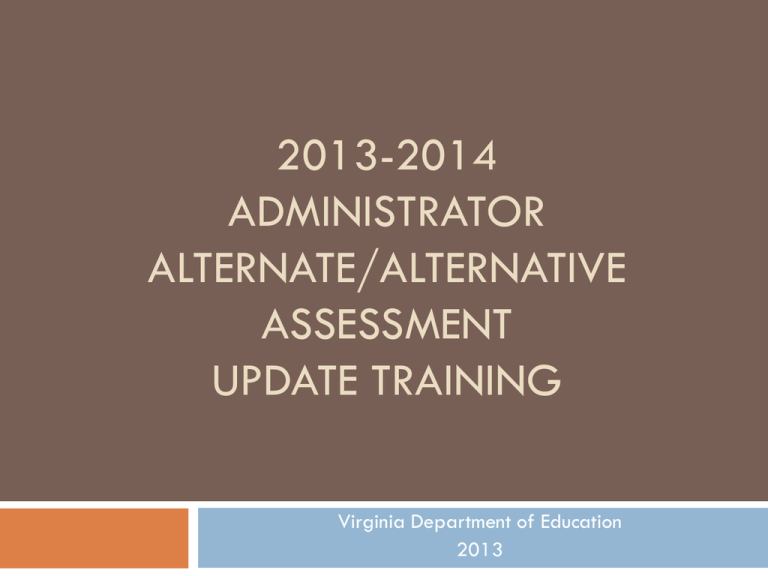
2013-2014 ADMINISTRATOR ALTERNATE/ALTERNATIVE ASSESSMENT UPDATE TRAINING Virginia Department of Education 2013 Administrator Alternate/Alternative Assessment Update Training 2 Welcome to Today’s Presentation We will be starting the training shortly. If you have not already called into the conference number, please call: 1-877-554-0877 Conference Code 319-358-4483 After dialing in, please mute your line by pressing *6. Presentation 3 If you did not receive the power point for this presentation, please e-mail Laura.ericksen@pearson.com Web Conference Schedule 4 Session 1 – August 13, 2013 9:30 – 11:30 AM Session 2 – August 14, 2013 9:30 – 11:30 AM Session 3 – August 20, 2013 1:30 – 3:30 PM Session 4 – August 21, 2013 1:30 – 3:30 PM During this web conference ... 5 Pearson will mute your phone line. If you join the presentation after phone lines have been muted, please mute your line by pressing *6. Time will be allotted for questions at the end of each assessment program update. Purpose of this Training 6 To update DDOTs, Special Education Directors, Title III Coordinators, and instructional leaders on pertinent issues and changes regarding the Virginia Grade Level Alternative (VGLA), the Virginia Substitute Evaluation Program (VSEP), the Virginia Alternate Assessment Program (VAAP), and the Virginia Modified Achievement Standards Test (VMAST). Administrators are expected to share this information with other school leaders, teachers, and parents. Program Updates will include… 7 Program Overview and Eligibility Information What’s New for 2013-2014 Important Reminders 2013-2014 Important Dates Information from 2012-2013 Scoring 2013-2014 Implementation Manuals will be referenced throughout the presentation. Implementation manuals are available locally from the Division Director of Testing and on the Virginia Department of Education web-site at http://www.doe.virginia.gov/testing/alternative_assessments/index.shtml 8 VGLA 2013-2014 Program Update VGLA 2013 - 2014 9 An evidence-based alternative assessment for the Standards of Learning (SOL) tests Available to eligible students with disabilities in grades 38 in Science, Writing, and History/Social Science Available to eligible Limited English Proficient (LEP) students in grades 3-8 in Reading only No program changes will be implemented in 2013-2014 2013 – 2014 VGLA Implementation Manual –p. vii Students with Disabilities 10 Eligibility determined by IEP Team/504 Committee and documented in the IEP or 504 plan. Eligibility determinations must be made on an individual and course-by-course basis. Eligibility must be based on Participation Criteria qualifying questions, supporting documentation, and justification statement. Participation Criteria forms and additional information are provided in the Procedures for Participation of Students with Disabilities in Virginia’s Accountability System available at www.doe.virginia.gov/testing/participation/index.shtml 2013– 2014 VGLA Implementation Manual –p. 1 Students with Disabilities 11 VGLA participation is determined by grade level and courses: Grade 3 – Science and History/Social Science Grade 5 – Writing and Science Grade 8 – Writing and Science VGLA Content Specific History (Virginia Studies, United States History I, United States History II, and Civics & Economics) may be provided to students with disabilities at the same grade levels as their non-disabled peers. 2013-2014 VGLA Implementation Manual – p. 1 LEP Students 12 Eligibility for VGLA Reading must be determined by the LEP team and documented in the student’s LEP plan. Eligibility decisions are based on: • • • WIDA ACCESS for ELLs Composite Score OR WIDA-ACCESS Placement Test (W-APT) OR WIDA Measurement of Developing English Language (Model) Assessment Additional information is available in Limited English Proficient Students: Guidelines for Participation in the Virginia Assessment Program available at www.doe.virginia.gov/testing/participation/index.shtml 2013-2014 VGLA Implementation Manual – p. 1 LEP Students with Disabilities 13 Referred to as “dually identified” students IEP/504 committees and LEP committees must work collaboratively to determine VGLA Reading participation and accommodations based on LEP and disability statuses. Assessment participation and accommodations must be documented in the IEP/504 plan and the LEP Assessment Participation Plan. 2013-2014 VGLA Implementation Manual – p. 1 Important Reminders 14 Anecdotal records and captioned photographs are not allowed as VGLA evidence. VGLA evidence must be collected under “ Testing Conditions” in which the student does not have access to materials or resources that would provide an unfair advantage. Multiple attempts to complete the same work sample are not allowed. Collections of Evidence (COE) should be monitored during development and pre-scored prior to scoring. 2013-2014 VGLA Implementation Manual – p. ix Important Dates VGLA 2013-2014 15 Oct. 1-2, 2013 VGLA Range-finding (Grades 3-5) Oct. 22-23, 2013 VGLA Range-finding (Grades 6-8) January 2- June 6, 2014 Register students for 2014 VGLA COE submissions (via Student Data Upload or manually) Jan. 28 &29, 2014 VGLA Scoring Training Sessions 1 and 2 March 31-June 6, 2014 VGLA Score Entry June 17, 2014 Shipping materials for COE selected for audit arrive in divisions June 23, 2014 Deadline to ship COE selected for audit to Pearson July 16, 2014 Preliminary score reports available in Pearson Access Supt. Memo #148-13 –May 31, 2012 Supt. Memo #148-13 –May 31, 2012 Scoring Issues from 2012 -13 VGLA Audit 16 Evidence failed to address: appropriate Depth of Knowledge Evidence violated Scoring Rule 1 (Student-Generated Work) • • Use of open-book Use of hints or clues Evidence showed multiple attempts Incomplete Student Evidence Identification (SEI)Tags • Bullets not specified Depth of Knowledge 17 Students are expected to demonstrate the depth of knowledge addressed by the SOL when completing work samples for the VGLA COE. If a work sample in the evidence does not demonstrate the depth of knowledge addressed by the SOL, the highest score point the student can achieve is “1.” Depth of Knowledge 18 All elements of the SOL stem and bullets must be demonstrated. Key verbs specified in the SOL indicate the cognitive demand that is expected. Helpful resources: • • VGLA Implementation Manual (Appendix B) SOL Curriculum Frameworks and SOL Enhanced Scope and Sequence www.doe.virginia.gov/testing/sol/standards_docs/index.shtml • Enhanced Scope and Sequence Plus • www.ttaconline.org/staff/sol/sol.asp Depth of Knowledge Categories Higher Order Thinking Analysis, Synthesis & Evaluation Application Using known information to solve new problems Comprehension Using recall information in a basic way such as explaining a concept in one’s own words Recall The lowest level of cognitive process involves remembering information 19 Sample Key Verbs Higher Order Thinking Analyze, Arrange, Categorize, Compare & Contrast, Conclude, Construct, Create, Diagram, Differentiate, Discriminate, Justify, Plan, Synthesize Application Compute, Demonstrate, Estimate, Give Examples, Graph, Illustrate, Interpret, Investigate, Predict, Solve, Use, Verify Comprehension Classify, Collect, Compare, Conduct, Contrast, Describe, Explain, Interpret, Locate, Order, Rephrase, Sequence, Summarize Recall Choose, Define, Identify, Label, List, Match, Observe, Quote, Recite, Select, State 20 Depth of Knowledge (Recall Demonstrated) 21 Science SOL 2.3 The student will investigate and understand basic properties of solids, liquids, and gases. Key concepts include a) identification of distinguishing characteristics of solids, liquids, and gases; Distinguishing characteristics are identified (recall). Depth of Knowledge (Comprehension Demonstrated) 22 Science SOL 2.3. The student will investigate and understand that matter is anything that has mass and takes up space; and occurs as a solid, liquid, or gas. Key concepts include a) distinguishing properties of each phase of matter; Some properties are distinguished (comprehension). Depth of Knowledge not Demonstrated 23 US. II.3 The student will demonstrate knowledge of the effects of Reconstruction on American life by analyzing the impact of the 13th, 14th, and 15th Amendments to the Constitution of the United States. The student is expected to demonstrate Higher Order Thinking Basic Provisions of the Amendments Only Recall understanding is demonstrated th th th Word bank: 13 Amendment 14 Amendment 15 Amendment Directions: Fill in the blanks with the correct answer. Depth of Knowledge not Demonstrated 24 US II.3 The student will demonstrate knowledge of the effects of Reconstruction on American life by describing the legacies of Abraham Lincoln, Robert E. Lee, and Frederick Douglass. The student is expected to demonstrate comprehension Only Recall understanding is demonstrated Scoring Rule 1 Violations Evidence must be Student-Generated 25 If the work sample is copied from sources such as the chalkboard/dry-erase board, texts, or computer, the work cannot be considered in scoring. If the work sample is based on a take-home test, open-book text, or homework, the work cannot be considered in scoring. If the work sample includes examples or directions with hints, clueing, or prompts that would provide answers or unfair advantage, the work cannot be considered in scoring. If the work sample is done as a part of a group project or assignment and the contribution of the student is not clearly identified, the work cannot be considered in scoring. Text Pages/Study Guides 26 Access to textbook is provided to answer questions. Hints and Clueing 27 The definition of quotation and information on correct punctuation is provided. Hints and Clueing 28 Information about Columbus’ voyages is provided to answer questions. Multiple Attempts 29 Student is given two attempts on the same worksheet. 30 VGLA Questions Please type your questions into the Chat Window and send to the host and presenter. 31 VSEP 2013 -2014 Program Update VSEP 2013 - 2014 32 An evidence-based alternative assessment for the Standards of Learning (SOL) tests Available to: • eligible students with disabilities enrolled in courses or those who have passed courses with End-of-Course SOL assessments and • students in grades 9-12 who need grade 8 numeracy and literacy certification for the Modified Standard Diploma Available with special permission for students with disabilities in grades 3-8 in mathematics and reading 2013 – 2014 VSEP Implementation Manual –p. 1 What’s New for 2013-14 33 VDOE will consider requests from school divisions to allow evidence presented in a multiple-choice format for selected students participating in the VSEP End-of-Course Writing assessment. Requests of this type may be appropriate for students with significant physical disabilities. Written requests must be submitted by the Director of Special Education to the Division of Student Assessment and School Improvement prior to the development of the Evaluation Plan Worksheet. This request is NOT an option for other End-Of-Course VSEP assessments. 2013-2014 VSEP Implementation Manual, p. 8 VSEP Courses 34 English: Writing English: Reading Algebra I Algebra II Geometry Biology Earth Science Chemistry Virginia and United States History World History I World History II World Geography 2013 – 2014 VSEP Implementation Manual –p. 1 List of the Content Areas and Corresponding Standards Available for VSEP Course Work Compilations (CWC)Submissions for the 20132014 Administrations Students in grades 9-12 VSEP CWC Submissions Current Standards Students in grades 9-12 VSEP CWC Submissions Previous Standards Numeracy- Grade 8 Mathematics (2009) Numeracy- Grade 8 Mathematics (2009) Literacy- Grade 8 Reading (2002) Literacy- Grade 8 Reading (2002) The SOL defended in the student’s CWC will depend on when the student was enrolled in the course. EOC Writing (2010) EOC Writing (2002) EOC Reading (2010) EOC Reading (2002) Algebra I (2009) Algebra I (2001) Students may be working on previous standards dating back to 2001. Geometry (2009) Geometry (2001) Algebra II (2009) Algebra II (2001 Revised) Earth Science (2010) Earth Science (2003) To ensure students defend the appropriate standards teachers should refer to the 2013-2014 VSEP Implementation Manual, p. 6 - 8. Biology (2010) Biology (2003) Chemistry (2010) Chemistry (2003) Virginia & U. S. History (2008) Virginia & U. S. History (2001) World History I (2008) World History I (2001) World History II (2008) World History II (2001) World Geography (2008) World Geography (2001) 35 • • • VSEP Courses 36 Grade 8 content areas for the Modified Standard Diploma Reading ( Literacy) Mathematics ( Numeracy) The modified standard diploma is only available to students who entered the 9th grade for the first time prior to the 2013-2014 school year. Grade 3-8 Special Permission Reading Mathematics 2013 – 2014 VSEP Implementation Manual –p. 1 Typical VSEP EOC Students 37 Are able to demonstrate achievement in grade level content; Are not able to access SOL tests even with accommodations due to the nature of their disabilities; Need an alternative method of demonstrating knowledge and skill. Typical VSEP Special Permission Students 38 Performs on grade level for the SOL in the subject/course to be assessed; May have a new disability, a rapid deterioration of sensory functions, or a unique and/or challenging disability that precludes access to the SOL even with accommodations. 2013-2014 VSEP Implementation Manual, p. 1 Eligibility Process 39 The IEP Team/504 Committee members complete the Intent to Participate form; The DDOT and Special Education Director review the form and the DDOT submits to the VDOE through the Single Sign-on Web Systems (SWSS)Drop Box; VDOE staff review the form to determine if the student has been selected based on VSEP participation criteria with supporting documentation and justification; 2013 – 2014 VSEP Implementation Manual –p. 2- 5 Eligibility Process 40 Review results are returned to the DDOT; Once approval is received, the VSEP Evaluation Plan/Worksheet is developed by the content teacher and the special education teacher; Evaluation Plan/Worksheet is submitted for local review. 2013– 2014 VSEP Implementation Manual –p. 2- 5 VSEP Resubmissions 41 Failing CWC can be resubmitted with additional evidence Intent to Participate form must indicate resubmission The VSEP Evaluation Plan/Worksheet and the resubmitted evidence must address SOL that received a failing or low score in the original submission. 2013-2014 VSEP Implementation Manual, p. 22 VSEP Request for Rescore 42 Divisions may request a failing VSEP CWC to be rescored if there is agreement between 2 division staff members with content expertise and knowledge of the VSEP rubric that the CWC should have received a higher score. Requests must be reviewed and approved by the division before submission to Pearson. DDOT must assure that the original evidence is submitted for rescore and has not been changed in any way. February 28, 2014 – Fall Request for Rescore Due Date July 2, 2014 – Spring Request for Rescore Due Date 2013-2014 VSEP Implementation Manual, p. iii & 22 Important Reminders 43 • • • • Anecdotal records, captioned photographs, and work samples in a multiple-choice format are not allowed as VSEP evidence. VSEP evidence must be collected under “ Testing Conditions” in which the student does not have access to materials or resources that would provide an unfair advantage. Multiple attempts to complete the same work sample are not allowed. CWC should be monitored during development and pre-scored prior to submission for scoring. • 2013-2014 VSEP Implementation Manual, p. x Important VSEP Dates for Submission of Intent to Participate Forms 44 • Students enrolled in Year long Courses Divisions are encouraged to submit as • Students enrolled in 1st early as possible. Late submissions will Semester Block Classes be reviewed only if there are • Fall Term Graduates October 4, 2013 extenuating circumstances. • Resubmissions considered for fall semester February 7, 2014 • Students enrolled in 2nd Divisions are encouraged to Semester Block Classes submit as early as possible. Late • Spring Term Graduates submissions will be reviewed only • Resubmissions considered if there are extenuating for Fall semester (Except for fall circumstances. 2013 resubmissions) February 21, 2014 • Resubmission of fall 2013 CWC Scoring Issues from 2012 - 13 VSEP Scoring 45 : Evidence fails to address appropriate Depth of Knowledge Evidence violates Scoring Rule 1 (Student-Generated Work) • • Use of open- book resources Use of web-based resources Depth of Knowledge Categories Higher Order Thinking Analysis, Synthesis & Evaluation Application Using known information to solve new problems Comprehension Using recall information in a basic way such as explaining a concept in one’s own words Recall The lowest level of cognitive process involves remembering information 46 Depth of Knowledge 47 All elements of the SOL stem and bullets must be demonstrated. Key verbs specified in the SOL indicate the cognitive demand that is expected. Helpful resources: • Depth of Knowledge Categories Based on Bloom’s Taxonomy VSEP Implementation Manual (Appendix F) The list of verbs in each knowledge category has been expanded. • SOL Curriculum Frameworks and SOL Enhanced Scope and Sequence www.doe.virginia.gov/testing/sol/standards_docs/index.shtml • SOL Enhanced Scope and Sequence Plus www.ttaconline.org/staff/sol/sol.asp Key Verbs Higher Order Thinking Analyze, Arrange, Categorize, Compare & Contrast, Conclude, Construct, Create, Diagram, Differentiate, Discriminate, Justify, Plan, Synthesize Application Compute, Demonstrate, Estimate, Give Examples, Graph, Illustrate, Interpret, Investigate, Predict, Solve, Use, Verify Comprehension Classify, Collect, Compare, Conduct, Contrast, Describe, Explain, Interpret, Locate, Order, Rephrase, Sequence, Summarize Recall Choose, Define, Identify, Label, List, Match, Observe, Quote, Recite, Select, State 48 Depth of Knowledge not Demonstrated 49 VUS. 9 The student will demonstrate knowledge of the emerging role of the United States in world affairs by b) evaluating United States involvement in World War I, including Wilson’s Fourteen Points, the Treaty of Versailles, and the national debate over treaty ratification and the League of Nations. The student is expected to demonstrate Higher Order Thinking Only Comprehension is demonstrated Open-Book Resources 50 . Access to information is provided from the text. Web-based Resources 51 . Internet access is provided to complete the worksheet. Video Guides 52 Access to a video guide is provided to answer the questions. 53 VSEP Questions Please type your questions into the Chat Window and send to the host and presenter. 54 VAAP 2013-2014 Program Update VAAP 2013-2014 55 An evidence-based alternative assessment for students with significant cognitive disabilities Available to eligible students with disabilities in grades 3-8 and high school who are working on academic content reduced in depth and complexity Available in reading, writing, mathematics, science and history High school students participating in VAAP must submit Collections of Evidence (COE) that include reading, writing, mathematics, science and history/social science by the end of their 11th grade school year or according to a schedule determined by the local school division. VAAP Division Flexibility for High School 56 Divisions have the option either to continue the submission of required VAAP content areas in grade 11 only or to develop a schedule in which one or more content areas are submitted in grades 9, 10, or 11. For example, the division may determine that VAAP Science will be collected in grade 9, History/Social Science in grade 10, and Reading, Writing, and Mathematics in grade 11. The Division Director of Testing (DDOT) should notify the Virginia Department of Education by September 30, 2013, regarding the schedule the division will implement for the 2013-2014 school year. Divisions should fill out the 2013-2014 Division High School Collection of Evidence Submission Schedule and submit using the Single Sign-on for Web Systems (SSWS) Dropbox to the attention of Lia Mason. Please consult your DDOT for your division’s schedule. Eligibility 57 Participation is determined by the IEP team based on the VAAP participation criteria. Participation Criteria forms and additional information are provided in the Procedures for Participation of Students with Disabilities in Virginia’s Accountability System available at www.doe.virginia.gov/testing/participation/index.shtml What’s New for 2013-2014 58 Student Evidence Multiple attempts by students to complete the same work samples via worksheets, tests, or quizzes are not accepted as evidence. Work samples that are submitted as evidence must not have been attempted before by the student individually or as a member of an instructional group. 2013-2014 VAAP Implementation Manual, p. vii What’s New for 2013-14 59 Local Scoring of VAAP Collections In 2013-2014, local school divisions will resume scoring all VAAP Collections of Evidence (COE). Audits of selected VAAP COE will be conducted in June. The purpose of the audit is to ensure that the school division scorers are appropriately applying the scoring rubric to student evidence. 2013-2014 VAAP Implementation Manual, p. vii Important Reminders 60 VAAP evidence must be completed under “testing conditions” in which the student does not have access to the subject content or curriculum, hints, clueing, prompts, or test taking strategies that would provide an unfair advantage. Anecdotal records submitted as evidence must include the date of performance, a detailed description of the learning environment, a detailed description of observed student performance, and a statement of accuracy describing the student’s level of achievement. 2013-2014 VAAP Implementation Manual, p. x Important Reminders 61 Teachers are required to select ASOL in the content areas of Reading, Writing, Mathematics, and Science from the grade level in which the student is enrolled. Teachers will not be permitted to select ASOL above or below the student’s grade level in these content areas. 2013-2014 VAAP Implementation Manual, p. 3 Selection of History ASOL 62 The selection of History/Social Science ASOL will continue to be determined by using the student’s grade level of enrollment as the starting point. If there are no appropriate History/Social Science ASOL at the student’s grade level, the ASOL may be selected from a higher or lower grade level for each reporting category. 2013-2014 VAAP Implementation Manual, p. 4 Important Dates VAAP 2013-2014 63 September 30, 2013 Deadline for divisions to dropbox the 2013-2014 Division High School Collection of Evidence Submission Schedule to VDOE January 2- March 31, 2014 Register students for 2014 VAAP Collections of Evidence (COE) submissions (via Student Data Upload or manually) Feb. 11-14, 2014 VAAP Scoring Training Sessions 1-4 March 31-May 23, 2014 VAAP Score Entry June 6, 2014 Shipping materials for COE selected for audit arrive in divisions June 13, 2014 Deadline to ship COE selected for audit to Pearson July 14, 2014 Preliminary score reports available in Pearson Access Levels of Performance 64 The Levels of Performance assist teachers in determining the level of performance for each ASOL that is most appropriate for the individual student. Level I: The ASOL is demonstrated with significant support • and modification • Level II: The ASOL is partially demonstrated • Level III: The ASOL is fully demonstrated 2013-2014 VAAP Implementation Manual, p. ix Level III – Full Demonstration 65 The ASOL is fully demonstrated. The student fully demonstrates the knowledge and skill of the ASOL. If the student’s performance is Level III, the highest score point the student can receive is “4.” If the student’s level of performance is not identified on the SEI Tag, the evidence will be scored as though it were a Level III. 2013-2014 VAAP Implementation Manual, p. ix Level III – Earning a “4” 66 5S-FME 2 The student will investigate and understand the characteristics of electricity. Key concepts include c) static electricity Annotation: The evidence for ASOL 5S-FME 2c is presented at Level of Performance III – the student fully demonstrates the ASOL. At this Level of Performance the highest score point that can be earned is a “4”. •The evidence was given credit for investigating static electricity by conducting an experiment with a balloon with 100% accuracy. •The evidence was also given credit for understanding the characteristics of electricity through the completion of a Smart board activity with 100% accuracy. Overall, for the Level of Performance III, the quality of the evidence presented consistently and appropriately satisfies most of the requirements of the ASOL. Level II – Partial Demonstration 67 The ASOL is partially demonstrated. The student demonstrates some of the knowledge and skill of the ASOL If the student’s performance is Level II, the highest score point the student can receive is “3.” If the student’s level of performance is not identified on the SEI Tag, the evidence will be scored as though it were a Level III. Level II – Earning a “3” 68 HSM-FS 3 The student will a) given data, construct a simple graph (table, line, pie, bar, or picture) and answer questions about the data. Annotation: The evidence for ASOL HSM-FS 3a is presented at Level of Performance II – the student partially demonstrates the ASOL. At this Level of Performance the highest score point that can be earned is a “3”. •The evidence shows a partial demonstration of the ASOL by eliminating the requirement to construct a simple graph. •The evidence was given credit for answering questions about given data with 100% accuracy. Overall, for the Level of Performance II, sufficient evidence is provided for the ASOL that has been partially demonstrated. Level II – Earning a “2” 69 On February 18, 2013, under Testing Conditions, was presented with a piece of coal. The teacher asked if the coal was hard or soft. She answered “no” to it being hard and then she answered “yes that it was a soft rock.” The second question was asked about what color and streak does it leave. In order to answer this we gave her three items with different colors. What color streak does it leave? She picked up the black color. What color is the coal? Again she chose the black color. She received a 100% on this activity. HSS-EMP 1a - The student will investigate and understand major rock-forming and ore minerals based on physical and chemical properties. Key concepts include a) hardness, color, and streak, luster, cleavage, fracture, and unique properties. Annotation: The evidence for ASOL HSS-EMP 1a is presented at Level of Performance II – the student partially demonstrates the ASOL. At this Level of Performance the highest score point that can be earned is a “3”. •The evidence shows a partial demonstration of the ASOL by eliminating the requirement to understand how to identify major rock-forming and ore minerals based on chemical properties. •The evidence was given credit for investigating and understanding physical properties of coal including hardness, color, and streak. There is no evidence of understanding luster, cleavage, fracture, or unique properties. Overall, for the Level of Performance II, the quality of the evidence presented does not satisfy many of the requirements of the ASOL. Level II – Earning a “1” 70 3M-NSCE 1 The student will a) identify and write numerals 0 to 30 Annotation: The evidence for 3M-NSCE 1a is presented at Level of Performance II – the student partially demonstrates the ASOL. At this Level of Performance the highest score point that can be earned is a “3”. •The evidence shows a partial demonstration of the ASOL by eliminating the requirement to write numerals 0-30. •The evidence was given minimum credit for identifying numerals 0 to 30. The evidence only identifies the number “2” and the number “9”. Overall, for the Level of Performance II, the quality of the evidence presented is weak and does not satisfy most of the requirements of the ASOL. Level I –Demonstrated with Significant Support and Modification 71 The ASOL is demonstrated with significant support and modification. The student requires significant support and modification to simplify the task in order to demonstrate the ASOL. If the student’s performance is Level I, the highest score point the student can receive is “2.” If the student’s level of performance is not identified on the SEI Tag, the evidence will be scored as though it were a Level III. Level I – Earning a “2” 72 3E-RW 4d The student will d) Demonstrate comprehension of information in reference materials by using dictionaries, glossaries, and indices Annotation: The evidence for ASOL 3E-RW 4d is presented at Level of Performance I – the student demonstrates the ASOL with significant support and modification. At this Level of Performance the highest score point that can be earned is a “2”. •The evidence shows the ASOL modified to a basic skill of locating words in a picture dictionary. The picture dictionary was the support provided. • The evidence was given credit for using a picture dictionary to locate words. •There is no evidence of using glossaries, indices, an additional dictionary, or the demonstration of comprehension of information. Overall, for the Level of Performance I, sufficient evidence is provided for the ASOL that has been demonstrated with significant support and modification. Level I – Earning a “0” 73 5E-WE 1 The student will b) produce all letters Annotation: The evidence for 5E-WE 1b is presented at Level of Performance I – the student demonstrates the ASOL with significant support and modification. At this Level of Performance the highest score point that can be earned is a “2”. •The evidence was not given credit because the student was provided models and tracing dots in order to produce upper and lowercase k’s. This violates Scoring Rule number 2 as described in the 2013-2014 VAAP Implementation Manual (page 14). Overall, the evidence submitted does not show any level of individual achievement for the ASOL being defended. 74 VAAP Questions Please type your questions into the Chat Window and send to the host and presenter. 75 VMAST Program Update VMAST 2013 - 2014 76 An online alternate assessment for the Standards of Learning (SOL) tests Research-based supports and simplifications are applied to existing online reading and Mathematics SOL items Available to eligible students with disabilities for grades 3-8 Mathematics and Reading as well as Algebra I and End-Of-Course Reading Eligibility Process 77 Eligibility determination must be made by the IEP team and documented in the student’s IEP. Students identified under Section 504 are not allowed to participate. Mathematics and Reading eligibility must be determined separately. Eligibility Process 78 IEP team must consider: • the student’s disability • impact of the disability on classroom performance, • need for significant instructional support to access grade level SOL and show progress • need for assessment supports to demonstrate knowledge, and • expectation regarding the achievement of grade level proficiency within the year. Participation Criteria forms and additional information are provided in the Procedures for Participation of Students with Disabilities in Virginia’s Accountability System available at www.doe.virginia.gov/testing/participation/index.shtml VMAST USE in 2014 -15 79 Beginning 2014-2015, the VMAST tests will no longer be available for grades 3-8 reading and mathematics. Students with disabilities who are pursuing a standard diploma using credit accommodations may continue to take the VMAST Algebra I and EOC Reading. VMAST USE in 2014-15 80 To use the VMAST as a credit accommodation, a student with disabilities must: • • • Must meet all current VMAST eligibility requirements Must pass the high school course Must score 374 or below on the End-of-Course Standards of Learning test after taking the test at least twice Students taking the VMAST in 2014-2015 will be counted as non-participants in federal accountability Important Reminders 81 Students participating in VMAST should become familiar with the supports and simplifications included by using the Practice Guides and Items that are available on the VDOE web site. A federally mandated cap of 2% is imposed on the number of VMAST passing scores that can be used in federal accountability. 82 VMAST Questions Please type your questions into the Chat Window and send to the host and presenter. 83 Alternate/Alternative Assessment Resources The Procedures for Participation of Students with Disabilities in Virginia’s Accountability System available at www.doe.virginia.gov/testing/participation/index.shtml The Virginia Department of Education Alternative/Alternate Assessment Webpage http://www.doe.virginia.gov/testing/alternative_assessme nts/index.shtml TTAC ONLINE http://www.ttaconline.org/ 84 Thank You for Participating! Please complete and submit the evaluation form that will be emailed to you by Pearson. Division of Student Assessment and School Improvement Student_Assessment@doe.virginia.gov (804) 225-2102

